Number System | Term 3 Chapter 1 | 7th Maths - Addition and Subtraction of Decimal Numbers | 7th Maths : Term 3 Unit 1 : Number System
Chapter: 7th Maths : Term 3 Unit 1 : Number System
Addition and Subtraction of Decimal Numbers
Operations on Decimal Numbers
Already we are familiar with decimal
numbers. We know how to represent a decimal number as a fraction and the place values
of digits. Now, let us learn the operations on decimal numbers.
Addition and Subtraction of Decimal Numbers
Iniya has purchased notebooks for ₹ 46.50
and a pencil box for ₹ 16.50. How much she will get as balance if she paid ₹ 100
to the shop keeper?
Price of a note book = ₹ 46.50 ; Price
of a pencil box= ₹ 16.50
To find the amount to be paid, we have
to add the price of both the items.
To get the balance amount we have to
subtract the total expense from ₹ 100. To know the total expenses and the balance
money, we need to understand addition and subtraction of decimals.
Addition and subtraction
of decimals through models
Decimal grid or area models can be used
to understand the process of addition and subtraction using decimal numbers.
(i) Grid model
We see below the grids to represent the
decimal numbers 1.0, 0.1 and 0.01.
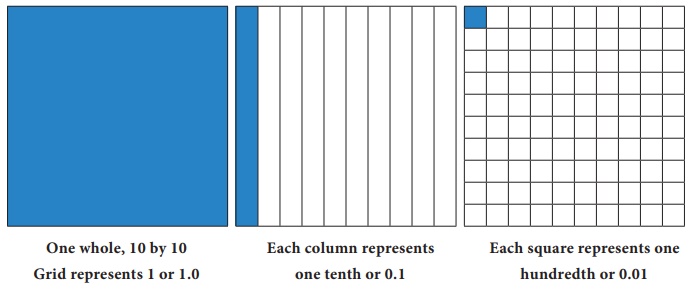
Having these grids let us try to do addition
and subtraction of decimal numbers.
Example 1.5
Find
the sum of 0.16 and 0.77 using decimal grid models.
Solution
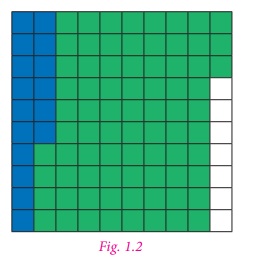
Here, 0.16= 16/100 and 0.77 =
77/100
First shade the region 0.16 and then
shade 0.77.
The total shaded area is the sum.
So, 0.16 + 0.77 = 0.93 .
Example 1.6
Find 0.52 – 0.08 using decimal grid models.
Solution
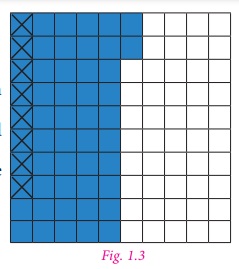
Here 0.52 =
52 / 100and 0 .08 = 8/100. First shade the region 0.52 then cross out 0.08, which
is 8/100 from the shaded area. The left out shaded region without cross marks is
the difference. So, 0.52 − 0.08 = 0.44 .
Example 1.7
Find the value of 0.72 − 0.51 by using
grids.
Solution
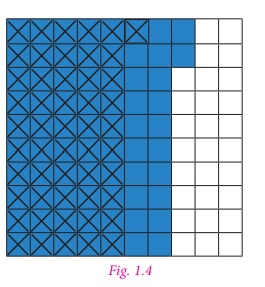
Take a square
of 100 boxes. Shade 72 boxes to represent
0.72.
Then strike
out 51 boxes out of 72 shaded boxes to subtract
0.51 from 0.72.
The left over
shaded boxes represent the required value.
Therefore,
0.72 – 0.51 = 0.21.
Try this
Find the following using
grid models:
(i) 0.83 + 0.04
Solution:
0.83= 83/100 and 0.04 = 4/100
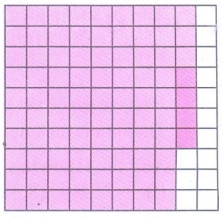
Shading the regions
0.83 and 0.04
The sum is the total shaded region.
S = 0.83 + 0.04 = 0.87
(ii) 0.35 – 0.09
Solution:
0.35 = 35/100 and 0.09 = 9/100
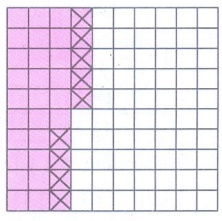
Shading the regions 0.35 by shading 35 boxes out of 100.
Striking off 9 boxes out of 35 shaded boxes to subtract 0.09 from 0.35.
The left over shaded boxes represent the required value.
0.35 - 0.09 = 0.26
(ii) Area model
The whole number (unit place) which is a part of
decimals represents a square area and 1/10 th part of this square area which is
a thin rectangular strip represents the tenth
place of the decimal (0.1) and 1/100 th part of this rectangular strip represents the hundredth place
value (0.01) and the same process will be continued for the next place and so on.

Having these square and rectangular area
let us try to do addition and subtraction of decimal numbers.
Example 1.8
Add 3.2 + 6.4.
Solution

Here 3.2 is represented in Blue colour
and 6.4 is represented in Green colour. Hence, the sum of 3.2 and 6.4 is 9.6.
Example 1.9
Subtract 7.5 – 3.4 .
Solution
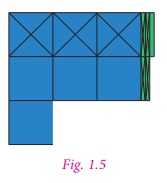
First represent
the decimal number 7.5 using 7 squares and 5 rectangular strips. Cross out 3 squares
from 7 squares and 4 rectangular strips from 5 rectangular strips to get the difference
(see Fig. 1.5).
Hence, 7.5 – 3.4 = 4.1
Try this
Using the area models solve the following:
(i) 1.2 + 3.5
Solution:
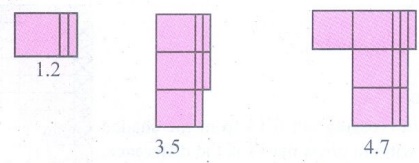
Here 1.2 is represented in
blue colour and 3.5 is represented in Green colour. Sum of 1.2 and 3.5 is 4.7.
(ii) 3.5 − 2.3
Solution:

Representing 3.5 using 3
squares and 5 rectangular strips. Crossing out 2 squares from 3 squares and 3
rectangular strips from 5 to get the difference. So 3.5 - 2.3 = 1.2.
(iii) Place value grid
model
So far we have
discussed grid models to do addition and subtraction of decimal numbers. Earlier
we have studied representation of decimal numbers in place value tables. Let us
use the same representation for addition and subtraction of decimal numbers.
For example,
while adding 4.83 and 1.67, we have

Therefore, 4.38 + 1.67 = 6.05.
Example 1.10
Add the following : (i) 30.9
+ 52.73 (ii) 25.67 + 33.856
Solution
(i) 30.9 + 52.73
Let us use the place value grid.

(Since the
digits in the decimal place of 52.73 is 2 and 30.9 is 1, we should add 0 at the
hundredth place of 30.9 to equalise the digits in the decimal place)
Therefore, 30.9 + 52.73 = 83.63.
(ii) 25.67 + 33.856
Let us use the place value grid.

Therefore, 25.67 + 33.856 = 59.526.
Note
Adding zeros at the right
end of decimal digits will not change the value of the number.
Example 1.11
Everyday Malar travels 1.820 km by bus and 295 m by walk to reach the school. Find the distance
of school from her house in km.
Solution
1000 m =1 km; 1 m = 1/1000 km
Hence, 295 m = 295/1000 km
= 0.295 km
Distance travelled by bus =1.820 km
Distance covered by walk = 0.295 km
Total distance = 1.820 + 0.295
=1.820 + 0.295
=2.115 km
Therefore, the school is situated at
the distance of 2.115 km from her house.
Example 1.12
Subtract 2.85 from 4.97.
Solution
4.97 – 2.85 = ?
Let us use the place value grid.

Therefore, 4.97 – 2.85 = 2.12.
Example 1.13
Subtract 3.09 from 12.7.
Solution
12.7 – 3.09 = ?
Let us use the place value grid.

Therefore, 12.7 – 3.09 = 9.61.
Note
1. We can equalize the decimal digits of given numbers by adding
zero at the right end of a decimal number that has only one decimal digit.
2. Zeros are added at the
right end of decimal digits of a decimal number that are to be added or subtracted.
Example 1.14
Subtract 32.042 from 86.9.
Solution
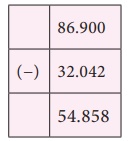
Therefore, 86.9 – 32.042 = 54.858.
Try this
Complete the magic square in such a way that rows, columns and diagonals
give the same sum 1.5.
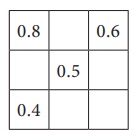
Solution
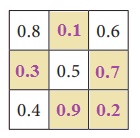
Example 1.15
Naren bought 7.4 kg of mangoes. On the way home,
he gave 4.650 kg of mangoes to his sister’s family. Find the weight of the remaining mangoes.
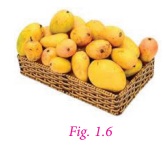
Solution
Mangoes bought by Naren = 7.4 kg
Mangoes given to Naren’s sister = 4.650
kg
Mangoes left for Naren’s family = 7.400
− 4.650
Weight of remaining mangoes = 2.750 kg
Therefore, the weight of the remaining
mangoes is 2.750 kg.

We use decimals every day, while dealing with money, weight, length etc. Decimal numbers are used in situations where more accuracy is required.
Related Topics